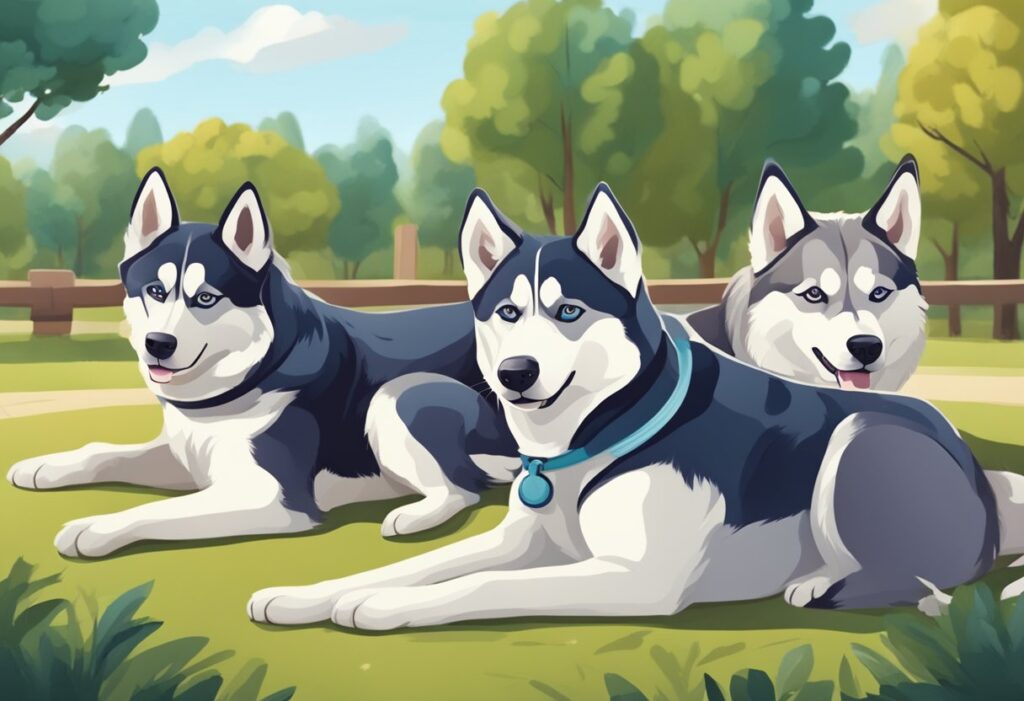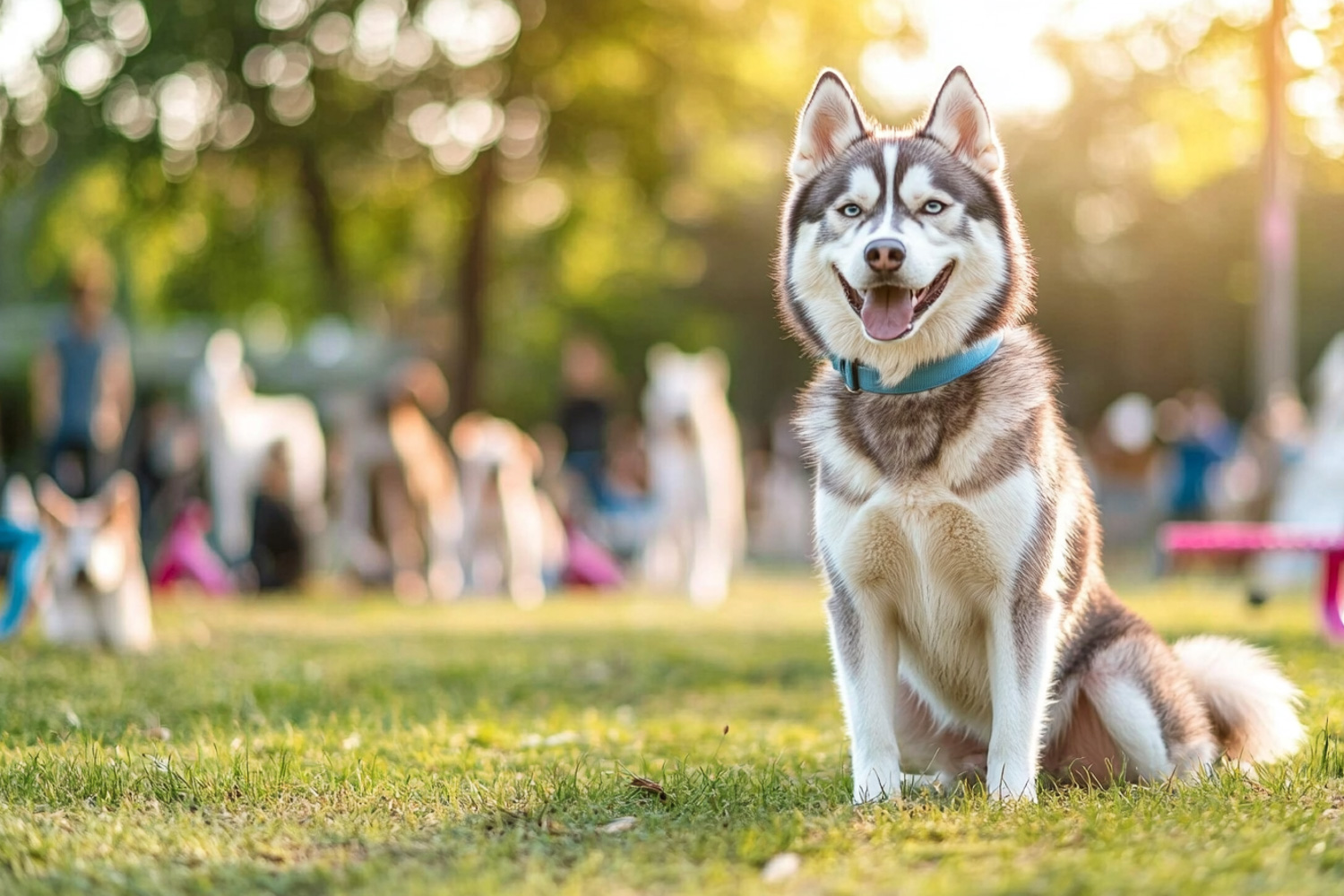Huskies are social creatures that thrive on companionship. They need proper socialization to become well-adjusted and confident dogs. Starting the socialization process early is key to raising a friendly and well-behaved husky.

Socializing a husky involves exposing them to different people, animals, and environments in a positive way. This helps them learn to handle new situations calmly. With the right approach, owners can help their huskies become sociable and outgoing.
Regular socialization throughout a husky’s life is important. It builds on their early experiences and keeps them comfortable in various settings. A well-socialized husky is a joy to be around and can adapt easily to different situations.
Key Takeaways
- Early socialization builds a husky’s confidence and social skills
- Positive experiences with new people and places are essential
- Ongoing socialization helps maintain a husky’s friendly nature
Understanding Husky Socialization
Socializing a Husky is key to raising a well-adjusted dog. This process shapes how Huskies interact with people, other animals, and their environment. It plays a big role in their behavior and temperament as adults.
The Importance of Early Age Introduction
Huskies need to meet new people and animals when they’re young. This helps them feel at ease in different settings. Puppy classes are great for this. They let Huskies play with other dogs safely.
Take your Husky to new places often. Parks, streets, and stores are good choices. Let them hear different sounds and see new sights. This builds their confidence.
Reward your Husky for calm behavior around new things. Use treats or praise. This teaches them that new experiences are good.
Socialization Period and Developmental Stages
Huskies have a key socialization period from 3 to 12 weeks old. During this time, they’re most open to new experiences. What they learn now stays with them for life.
At 3-5 weeks, Huskies start to play with their littermates. This teaches them how to interact with other dogs.
From 5-7 weeks, they become more aware of their surroundings. This is a good time to introduce them to different textures and surfaces.
Between 8-12 weeks, Huskies are ready to meet new people and animals. Take them on short trips outside the home.
Identifying Signs of Fear or Aggression
Watch your Husky’s body language during socialization. Tucked tails, flattened ears, or growling can mean they’re scared or upset.
If your Husky shows these signs, don’t force them into the situation. Give them space and try again later.
Some Huskies may bark or lunge when afraid. This doesn’t mean they’re bad dogs. It means they need more gentle exposure to new things.
If fear or aggression persists, talk to a dog trainer. They can help make a plan to build your Husky’s confidence.
Remember, each Husky is unique. Some may need more time to adjust than others. Be patient and keep socialization positive.
Developing Positive Interactions
Socializing a Husky involves creating positive experiences with people, animals, and new environments. This helps build a well-adjusted dog that is comfortable in different situations.
Creating Positive Encounters with People
Exposing Huskies to different people is key for socialization. Invite friends and family to meet the dog in a calm setting. Use treats and praise to reward good behavior during these meetings.
Take the Husky to public places like parks or pet stores. This lets them see people of all ages, sizes, and appearances. Keep visits short at first to avoid stress.
Teach children how to safely interact with the dog. Show them how to pet gently and avoid sudden movements. Always supervise kids and dogs together.
Socializing with Other Animals and Dogs
Introduce the Husky to other dogs slowly and in neutral areas. Start with calm, friendly dogs to build good experiences. Watch body language and step in if needed.
Set up playdates with trusted dogs. This helps Huskies learn proper social skills and doggy etiquette. Keep sessions short and fun.
Expose the Husky to other animals like cats, birds, or small pets. Use a leash and rewards to keep interactions positive. Never force interactions if either animal seems scared.
Introducing Various Environments and Situations
Take the Husky to different places to build confidence. Visit quiet parks, busy streets, and indoor spaces. Let them explore at their own pace.
Expose them to various sounds and sights. This could include traffic noise, appliances, or crowds. Pair these with treats to create good associations.
Practice handling the Husky’s paws, ears, and mouth. This makes vet visits and grooming easier. Give lots of praise and treats during these exercises.
Try different surfaces like grass, gravel, or tile. This prevents fear of new textures. Use treats to encourage the Husky to walk on unfamiliar ground.
Training and Exposure Techniques
Training and exposure help Huskies become well-socialized dogs. These methods teach proper behavior and build confidence in different settings. Positive experiences are key to a happy, social Husky.
Utilizing Playdates and Dog Parks
Playdates let Huskies interact with other dogs in a controlled setting. Start with calm, friendly dogs to build positive associations. Keep sessions short at first, about 15-20 minutes.
Dog parks offer more freedom but need caution. Visit during quiet times to avoid overwhelming your Husky. Watch for signs of stress or fear. If your dog seems nervous, leave and try again another day.
Both options help Huskies learn dog body language and social skills. They also burn energy, which is great for this active breed.
Obedience Classes and Professional Training
Group classes teach Huskies to focus around distractions. They learn basic commands like sit, stay, and come. Classes also expose them to different people and dogs in a structured way.
A professional trainer can address specific issues. They may use clicker training or other methods suited to Huskies. Trainers can also guide owners on handling this strong-willed breed.
Consistency is crucial in training Huskies. Practice commands daily, even for just a few minutes. This helps reinforce good habits and strengthens the bond between dog and owner.
The Role of Toys and Treats in Socializing
Toys and treats make training fun for Huskies. Use them to reward good behavior during social situations. This creates positive links with new experiences.
Introduce new toys slowly. Let your Husky explore them in a calm setting first. Then use them as distractions or rewards when meeting new people or dogs.
Treats should be small and healthy. Use them sparingly to avoid overfeeding. Praise is just as important as treats. A happy tone of voice can be very rewarding for Huskies.
Rotate toys to keep things interesting. This helps prevent boredom and encourages engagement during training sessions.
Maintaining Sociability Throughout Life

Keeping a Husky social takes effort throughout its life. Regular exposure to new experiences helps them stay confident and well-adjusted.
Continued Socialization into Adulthood
Adult Huskies need ongoing social contact. Take them to dog parks or on walks in busy areas. This helps them stay comfortable around people and other dogs.
Expose them to different sights and sounds. Let them see cars, bikes, and strollers. Take them on public transport if allowed.
Invite friends over regularly. This keeps Huskies used to meeting new people. Reward calm behavior around guests with treats and praise.
Addressing Behavioral Issues Proactively
Watch for signs of fear or aggression. These can include growling, hiding, or barking at normal things. Address issues early before they get worse.
Use positive reinforcement to change behavior. Reward good reactions to scary things. This builds confidence over time.
If problems persist, talk to a dog trainer. They can give tips for your specific Husky. Some issues may need a vet check to rule out health problems.
Involvement with New Experiences and Challenges
Keep life interesting for your Husky. Take them to new places often. Try hiking trails, beaches, or city walks.
Introduce them to new objects at home. Let them see and smell things like umbrellas or suitcases. This builds trust in unfamiliar items.
Use puzzle toys to challenge their mind. Hide treats in toys or boxes. This keeps them busy and builds problem-solving skills.
Try new activities together. Agility courses or nose work classes can be fun. These build your bond and keep your Husky engaged.


Leave a Reply